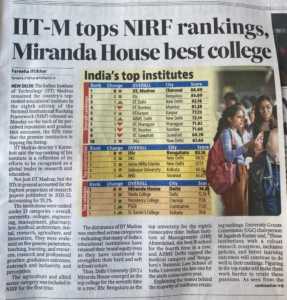NIRF 2023: National Institute Ranking Framework
Brief Introduction
The National Institutional Ranking Framework is an initiative by the Ministry of Education/HRD, Government of India. It was launched in 2015 to rank higher education institutions in India. The Rankings for the year 2023 was released on June 6th 2023, brief analysis of which is presented in this article. Have a look at it.
The NIRF rankings are based on several parameters concerning learning, teaching, and resources; research & professional practice; graduation outcomes; outreach and inclusivity; and perception. The rankings are considred a valuable tool for students, parents, and policymakers to compare different universities and institutions in India. The NIRF rankings are released annually and have become a widely accepted benchmark for assessing the quality of higher education institutions in India.
As many as 1,000 institutions have been covered under the NIRF 2023 Rankings, details of which can be seen below in the Table:
Number of Universities & Institutions Covered in NIRF 2023 by Type
| Type | Number of institutions |
| Universities | 875 |
| Colleges | 115 |
| Schools | 10 |
| Hospitals | 0 |
The NIRF rankings are an excellent way to compare universities and institutions in India. However, rankings are not the only factor to consider when choosing a university. Other factors, such as the cost of attendance, the location of the university, and the specific programs offered by the university, may also be necessary.
Methodology of NIRF
The National Institutional Ranking Framework methodology is developed by the Ministry of Education/Human Resource Development of India to rank higher education institutions in the country. The NIRF rankings are released annually and have become a widely accepted benchmark for assessing the quality of higher education institutions in India.
The NIRF rankings, which are based on a set of objective criteria, are grouped into five broad categories:
- Teaching, Learning, and Resources (TLR):Through this category, the quality of teaching & learning at the institution level, as well as the availability of resources such as libraries, laboratories, and faculty, is measured.
- Research and Professional Practices (RPC):This category measures the institution’s research output, as well as its engagement with industry and the community.
- Graduation Outcomes (GO):This category measures the performance of the institution’s students, as measured by their placement rates, research publications, and awards.
- Outreach and Inclusivity (OI):This category measures the institution’s efforts to reach underrepresented groups, such as students from rural areas or minority communities.
- Perception (PER):This category measures the institution’s reputation, as measured by a survey of experts and stakeholders.
Each of these categories is assigned a weight, and the overall ranking of an institution is determined by its score in each category. The NIRF rankings are valuable for students, parents, and policymakers. They can help students make informed decisions about where to study and help policymakers identify areas where improvements are needed in the higher education system.
The NIEF rankings qualitative criteria are further grouped into the following four broad categories:
- Teaching and Learning (TL)
- Research and Innovation (RI)
- Outreach and Connectivity (OC)
- Governance & Financial Sustainability (GFS)
The key features of the NIRF methodology are summarized below:
- The NIRF rankings are based on objective criteria designed to be transparent and reproducible.
- The NIRF rankings are released annually, which allows institutions to track their progress over time.
- The NIRF rankings are widely accepted by students, parents, and policymakers, which makes them a valuable tool for assessing the quality of higher education institutions in India.
The NIRF rankings have been criticized for being too focused on research & not giving enough weight to teaching and learning. The rankings have also been criticized for being too subjective and not based on complex data. Despite criticisms, the NIRF and the NIEF rankings have become essential tools for students, parents, and policymakers. They can help students make informed decisions about where to study and help policymakers identify areas where improvements are needed in the higher education system.
The NIRF 2023 Rankings
In the NIRF 2023 rankings, overall, the Indian Institute of Technology Madras (IIT Madras) is ranked first, followed by the Indian Institute of Technology Delhi (IIT Delhi) and the Indian Institute of Technology Bombay (IIT Bombay). IIT Madras was ranked first in the engineering category, followed by IIT Delhi and IIT Bombay. In the management category, the Indian Institute of Management Ahmedabad (IIM Ahmedabad) was ranked first, followed by the Indian Institute of Management Bangalore (IIM Bangalore) and the Indian Institute of Management Calcutta (IIM Calcutta).
The Top 15 Institutions: NIRF 2023
A few key findings of the NIRF 2023 rankings are summarized below:
- The top 100 institutions in the NIRF rankings are concentrated in a few states, such as Delhi, Maharashtra, and Tamil Nadu.
- The government-funded institutions dominate the NIRF rankings, with private institutions making up a small minority.
- The NIRF rankings show a wide range of quality among higher education institutions in India.
- The NIRF rankings can be used to identify institutions performing well and areas where improvements are needed.
Here is the list of the Top 15 institutions based on the NIRF 2023 Rankings:
- Indian Institute of Technology Madras (IIT Madras)
- Indian Institute of Science (IISc)
- Indian Institute of Technology Delhi (IIT Delhi)
- Indian Institute of Technology Bombay (IIT Bombay)
- Indian Institute of Technology Kanpur (IIT Kanpur)
- Indian Institute of Technology Kharagpur (IIT Kharagpur)
- Indian Institute of Technology Roorkee (IIT Roorkee)
- Indian Institute of Technology Guwahati (IIT Guwahati)
- AIIMS: All India Institute of Medical Sciences, New Delhi
- Jawaharlal Nehru University (JNU)
- Banaras Hindu University (BHU)
- University of Delhi
- Indian Institute of Technology Hyderabad (IIT Hyderabad)
- National Institute of Technology (NIT) Tiruchirappalli
- Indian Institute of Technology Indore (IIT Indore)
Compare NIRF 2022 & NIRF 2023 Rankings
The National Institutional Ranking Framework (NIRF) and the National Institutional Excellence Framework (NIEF) are two different ranking systems for higher education institutions in India. The NIRF rankings are released annually, while the NIEF rankings are released biennially.
Here is a comparison of the top 10 institutions in the NIRF & NIEF rankings for 2022 & 2023:
| Institution | NIRF 2022 | NIEF 2022 | NIRF 2023 | NIEF 2023 |
| Indian Institute of Technology Madras | 1 | 1 | 1 | 1 |
| Indian Institute of Science | 2 | 2 | 3 | 3 |
| Indian Institute of Technology Delhi | 3 | 3 | 2 | 2 |
| Indian Institute of Technology Bombay | 4 | 4 | 4 | 4 |
| Indian Institute of Technology Kanpur | 5 | 5 | 5 | 5 |
| Indian Institute of Technology Kharagpur | 6 | 6 | 6 | 6 |
| Indian Institute of Technology Roorkee | 7 | 7 | 7 | 7 |
| Indian Institute of Technology Guwahati | 8 | 8 | 8 | 8 |
| All India Institute of Medical Sciences | 9 | 9 | 9 | 9 |
The above Table reveals much overlapping between the top 10 institutions in the NIRF and NIEF rankings, suggesting that both ranking systems effectively identify India’s best higher education institutions. There are a few significant differences between the two ranking systems. For example, the Indian Institute of Technology Madras is ranked first in the NIRF rankings, but it is ranked third in the NIEF rankings. This suggests that the NIRF rankings may focus more on research, while the NIEF rankings may focus more on teaching and learning.
Ultimately, the best way to choose a higher education institution is to consider all of the available information, including the NIRF and NIEF rankings. Factors such as the institution’s location, cost, and programs and courses must also be considered while selecting an institution.
The Top 10 Universities: NIRF 2023
The following are the top 10 universities in India as per NIRF 2023:
- Indian Institute of Science (IISc), Bangalore
- Jawaharlal Nehru University (JNU), New Delhi
- Jamia Millia Islamia, Delhi
- Jadavpur University, Kolkata
- Banaras Hindu University (BHU), Varanasi
- Manipal Academy of Higher Education (MAHE), Manipal
- Amrita Vishwa Vidyapeetham, Coimbatore
- Vellore Institute of Technology (VIT), Vellore
- Aligarh Muslim University (AMU), Aligarh
- University of Hyderabad, Hyderabad
The IISc has been ranked as the country’s top university in the National Institutional Ranking Framework rankings for 2023. The IISc has been ranked first for the sixth consecutive year.
As mentioned above, the NIRF rankings are based on numerous parameters, such as teaching, learning & resources, research & professional practice, graduation outcomes, outreach and inclusivity, and perception. The IISc has been praised for its robust research output, faculty and student quality, and infrastructure. The university has also been credited with playing a pivotal role in developing India’s technological and scientific prowess.
The other universities in the top 10 are also highly regarded for their academic excellence. JNU is known for its humanities and social sciences programs, while Jamia Millia Islamia is a leading university for Islamic studies. Jadavpur University is a premier institution for engineering and science, while BHU is one of India’s oldest and most prestigious universities.
The top 10 universities in India offer a wide range of courses and programs, and they are all committed to providing high-quality education.
Top 10 Engineering Colleges: NIRF 2023 Rankings
- IIT Madras, Chennai, Tamil Nadu
- IIT Delhi, New Delhi, Delhi
- Indian Institute of Technology Bombay, Mumbai, Maharashtra
- Indian Institute of Technology Kanpur (IIT Kanpur), Kanpur, Uttar Pradesh
- Indian Institute of Technology Roorkee, Roorkee, Uttarakhand
- IIT Kharagpur, Kharagpur, West Bengal
- Indian Institute of Technology Guwahati (IIT Guwahati), Guwahati, Assam
- Indian Institute of Technology Hyderabad, Hyderabad, Telangana
- National Institute of Technology Tiruchirappalli (NIT Trichy), Tiruchirappalli, Tamil Nadu
- Jadavpur University (JU), Kolkata, West Bengal
These colleges are all highly regarded for their academic excellence and research output. They offer a wide range of engineering programs, & graduates produced by them are highly rated and sought-after by employers. When making decisions and selecting an engineering college, it is essential to consider other factors, such as the college’s location, cost, and culture.
NIRF 2022 Vs.NIRF 2023 Rankings
A comparison of the top 15 institutions based on NIRF 2022 and NIRF 2023 ranking is presented below:
| Rank | Institution | NIRF 2022 | NIRF 2023 | Change |
| 1 | Indian Institute of Science | 1 | 1 | No change |
| 2 | Indian Institute of Technology Bombay | 2 | 2 | No change |
| 3 | Indian Institute of Technology Delhi | 3 | 3 | No change |
| 4 | Indian Institute of Technology Madras | 4 | 4 | No change |
| 5 | Indian Institute of Technology Kharagpur | 5 | 5 | No change |
| 6 | Indian Institute of Technology Kanpur | 6 | 6 | No change |
| 7 | Indian Institute of Technology Roorkee | 7 | 7 | No change |
| 8 | Indian Institute of Technology Guwahati | 8 | 8 | No change |
| 9 | Indian Institute of Technology Hyderabad | 9 | 10 | Down one rank |
| 10 | Indian Institute of Technology Banaras Hindu University | 10 | 9 | Up one rank |
| 11 | University of Delhi | 11 | 11 | No change |
| 12 | All India Institute of Medical Sciences | 12 | 12 | No change |
| 13 | National Institute of Technology Tiruchirappalli | 13 | 13 | No change |
| 14 | National Institute of Technology Durgapur | 14 | 14 | No change |
| 15 | National Institute of Technology Calicut | 15 | 15 | No change |
One may observe that there is no major change in the top 15 institutions in the NIRF ranking 2023. The Indian Institute of Science continues to be the top-ranked institution in India, followed by the Indian Institute of Technology Bombay, Delhi, and Madras. The only change in the top 15 is that the Indian Institute of Technology Hyderabad has moved down one rank to 10. In comparison, the Indian Institute of Technology Banaras Hindu University has moved up one rank to 9.






